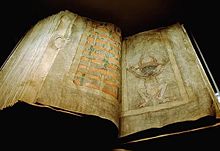Giant bible
As a giant Bible large-be Bible referred -Handschriften that emerged from the mid-11th century.
history
In the 11th century, the papal reform efforts promoted an in-depth study of the Bible. In this context, mostly two-volume giant Bibles ("bibbie atlantiche") were first created in central and northern Italy. The large format underlined the importance of the scriptures written in the book. The Carolingian Bibles, which had been mass-produced between around 800 and 850 in abbeys such as Saint-Martin in Tours, served as a template for the text .
In the 12th century Bibles based on the Italian model were also produced north of the Alps, with an independent Romanesque style of painting developing.
After the development of the printing press , large-format Bible manuscripts were no longer produced.
generation
Creating a large, multi-volume, giant Bible was a huge challenge for a scriptorium . The effort in terms of working time and material was enormous. In a traditional case, the skins of 155 calves were required for the oversized parchment sheets. It took four years to copy, illuminate, and bind the giant Tournai Bible. Several scribes were usually involved in writing the text, who divided their work into different sections.
description
The giant Bibles are on average about 65 cm high and 40 cm wide. The largest giant Bible comes from Bohemia , the so-called Codex Gigas is 90 by 50 cm, making it one of the largest surviving manuscripts in the world.
The initials several lines high were not only decorative elements, but, like the marginal glosses, also served as orientation for the reader, because the division of the Bible text into chapters and verses was only later made by the British Archbishop Stephan Langton in the 13th century and by the Parisian printer Robert Estienne in Made 16th century.
Metal paints, opaque paints and sometimes silver and gold were used for the paintings.
use
The gigantic Bibles were read aloud in the Liturgy of the Hours and in the service. Because of its weight, a giant Bible could only be carried with difficulty from one place to another. A giant Bible that is constantly in use is therefore likely to have been lying on its own lectern in the choir of an abbey church all year round. Due to the frequent turning of the pages, most of the page corners were badly worn.
Examples
Giant Bibles in Italy:
- Bibbia del Pantheon (Pantheon Bible), Vatican, No. 12958
- Bibbia di Calci , giant Bible of the Certosa di Pisa in Calci (1168; 56 × 38 cm)
- Bibbia di Perugia , Perugia , Biblioteca Comunale Augusta, L 59
- Bibbia di Santa Cecilia , Vatican, Barb. lat. 587
- Bibbia di Santa Maria del Fiore , Florence, Biblioteca Medicea Laurenziana , Edili 125–126
- Bibbia di Todi , Vatican, no.10405
- Bibbia Urbinate ( Federico da Montefeltro's Bible ), Vatican, Urb. Lat. 1 and 2 (1476–1478; 59.8 × 44.3 cm)
Giant Bibles in Austria:
- Giant Admont Bible in Admont Abbey , Upper Austria
- Babenberg Giant Bible in Klosterneuburg Abbey , Lower Austria
- Millstatt Giant Bible in the Millstatt Abbey Museum , Carinthia
- Giant Bible from Nonnberg (fragment), Salzburg
- Giant Bible from St. Florian , Upper Austria, Codex XI 1 (1140/50; 66 × 48 cm)
- Walther Bible by Michaelbeuern
Giant Bibles in Germany:
- Gumbertus Bible from Regensburg (late 12th century; 67 × 46 cm)
- Giant Mainz Bible in the ducal library in Gotha, Thuringia (1452–1453; 55 × 40 cm)
- Maximiner Riesenbibel ( Giant Bible of St. Maximin ) from the Imperial Abbey of St. Maximin near Trier, today in private ownership
- Giant Bible of Heinrich IV. , Bavarian State Library, No. 13001
Other giant Bibles:
- Codex Gigas from Bohemia (13th century; 92 × 50 cm)
- Giant Bible from Tournai , Belgium
Web links
- Giant bible. In: medieval-lexikon.de.
Individual evidence
- ↑ a b c Friedrich Buchmayr , Karl Rehberger , Friedrich Simader: The giant Bible of St. Florian (= Codices Illuminati. Masterpieces from the collections of the most important libraries in the world. II. Abbey and monastery libraries, Volume 5). Akademische Druck- und Verlags-Anstalt, Graz 2008, ISBN 978-3-201-01886-9 , pp. 33–34.
- ↑ a b Buchmayr / Rehberger / Simader 2008, p. 15.
- ↑ Werner Telesko: The "giant bibles" and the problem of the "reform style" in Salzburg illumination of the late 11th and early 12th centuries: reflections on the meaning of the Admont Bible manuscripts C - E and the St. Florian giant Bible. In: Journal of the Historical Association for Styria. Born in 1988/89, pp. 13–14 ( PDF on historerverein-stmk.at).

